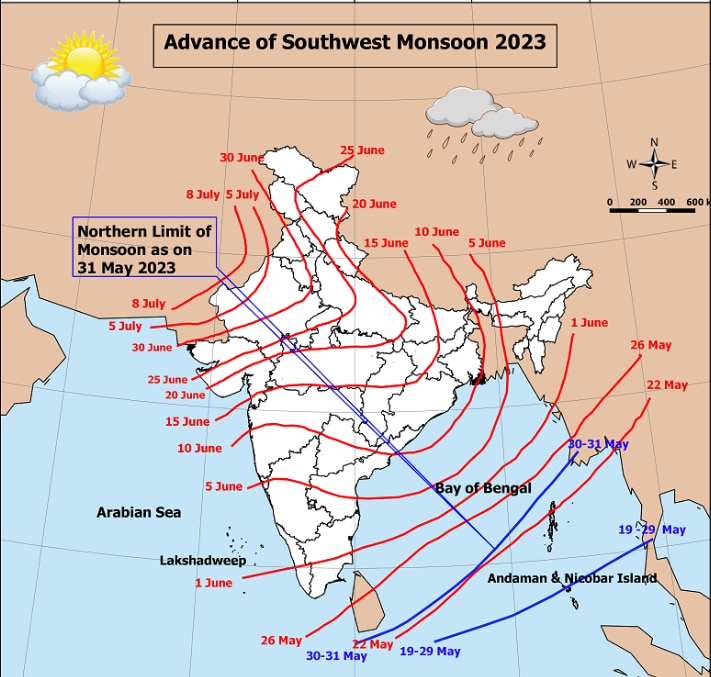Every year in the month of June, there was severe heat in different parts of the country. If you look at the weather of the last few years, you will find that till this month i.e. till June, in many states the temperature rises above 50 degree Celsius due to heat wave.
This process of rising temperature in India starts from the month of March itself. The sun remains in its full glory till the month of April and May. But according to the data of the Meteorological Department, this year the heat wave has been from 11th to 20th in April and from 6th to 12th in May. For the first time in 9 years, it has been seen that there was no heat wave in the month of May and there has been a drop in the temperature.
This series of unseasonal rains in the country was not limited to northern India only. Rather, the situation has been more or less the same in South, West, Central and East India as well.
Meanwhile, the Meteorological Department has given a lot of information about the arrival of monsoon. Monsoon, which was stalled for the last 11 days, has moved ahead in the Bay of Bengal. Monsoon is moving towards Myanmar covering entire Andaman and Nicobar Islands. Kashmir’s temperature has dropped due to heavy rains. According to IMD, monsoon will knock in most of the states of the country by June 15.
In fact, on May 19, 2023, the Meteorological Department had told that at that time the southwest monsoon was to pass through the northernmost tip of the Andaman and Nicobar Islands and move towards Myanmar by May 22, 2023. There has been a delay of at least eight days in the onset of monsoon.

Why is it raining without any season in the month of April-May?
According to meteorologists, climate change and western disturbance have been the biggest reason for the unseasonal rains in the months of April-May this year. year 2023 In the month of April, there were 5 Western Disturbances continuously and their coming is still going on. The coming Western Disturbance this time is more than the previous years.
Cyclonic winds are formed due to Western Disturbance and it is currently over Haryana and Punjab. This is the reason why it is raining continuously from North to West India.
Apart from this, the trough line is also responsible for the rains in India. The trough line pulls moist winds from the Arabian Sea and Bay of Bengal together. Due to which clouds are formed from it and monsoon becomes active. At present, the trough line is being formed from Madhya Pradesh to Tamil Nadu.
If understood in simple language, on one side, eastern winds and south-easterly winds are coming from the Bay of Bengal. On the other hand, southwest winds are coming from the Arabian Sea. Winds from both the sides are meeting in Madhya Pradesh and clouds are forming.
(Photo Credit- Indian Meteorological Department / IMD)
Why is the weather pattern changing
Earlier in the month when it used to rain in India, now in the same month people are shivering due to cold. Or the month in which people were troubled by the heat, now it rains in the same month. This pattern of changing weather in the country is said to be the effect of climate change. With the passing years, gradually the weather pattern also kept changing.
Simply put, climate change is increasing global warming and instability in the monsoon, due to which the duration of the summer season is increasing and the duration of the rains is decreasing. The year 2022 has seen the second largest number of extreme events since 1902. Dangerous incidents like flood and drought have increased.
What is climate change?
Climate is the average weather of a place over a long period of time or over a number of years. Climate change is due to the change in those conditions. One of the reasons for the change in weather trends in the last 50 years is climate change, the biggest culprit of which is human activities.
In the last few years, the use of human oil, gas and coal has increased for domestic works, factories and operations. Which has an adverse effect on the climate.
During the burning of fossil fuels, the fuel that comes out of it contains the most carbon dioxide in the greenhouse gas. Due to the presence of these gases, the heat of the sun in the atmosphere does not go outside the earth and in such a situation the temperature of the earth starts increasing.
Compared to the 19th century, the temperature of the earth has increased by about 1.2 Celsius in the 20th century and the amount of CO2 in the atmosphere has also increased by 50 percent.





